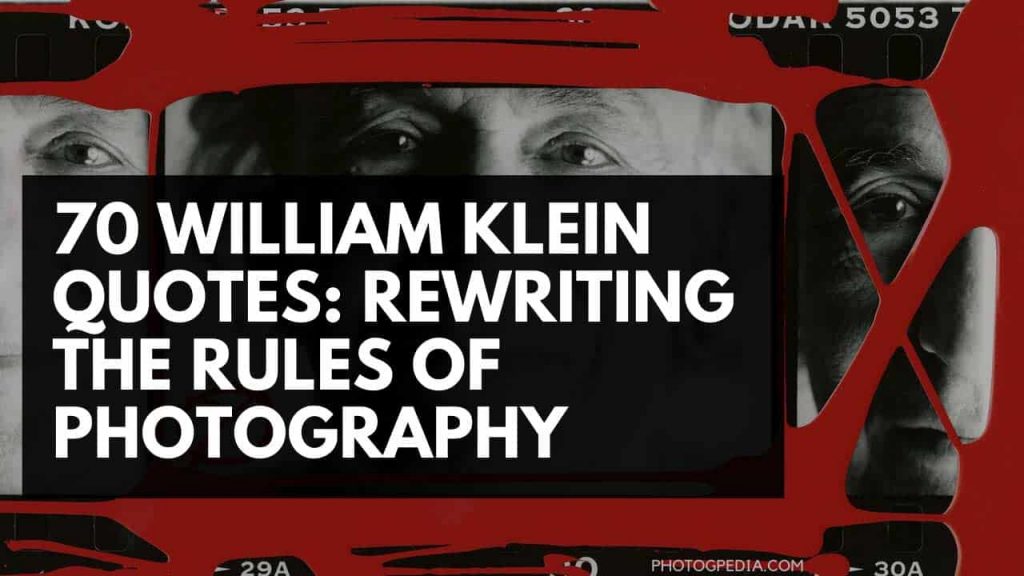William Klein was a pioneer of 20th century photography. His raw, dramatic images of ’50s New York helped create the art of street photography and his distinctive style influenced generations of photographers around the world.
Klein was also an innovative fashion photographer and made several films, including the first ever Muhammad Ali documentary and a feature length satire on the fashion world, Who Are You, Polly Maggoo?
In this article we’ll be sharing our favorite William Klein quotes to help to your photography to the next level. If you find the article helpful, we would be grateful if you could share it with other photographers.
William Klein Quotes
Every photograph, I look at the contact, it brings back memories of everything, how I was feeling, tired, full of beans, photography is like that.
You look at a contact sheet with a magnifying glass and you see a shot, suddenly it all comes back – that was a nice day, you wanted a walk, your feet were hurting, you felt that you would hit on something.
I think there are two kinds of photography… If you look at modern photography, you will find, on the one hand the Weegees, the Diane Arbuses, the Robert Franks – funky photographs. And then you have the people who go out in the woods. Ansel Adams, Weston. It’s like black and white jazz.
I liked Cartier-Bresson’s pictures, but I didn’t like his set of rules. So I reversed them. I thought his view that photography must be objective was nonsense. Because the photographer who pretends he’s wiping all the slates clean in the name of objectivity doesn’t exist.
Anybody who pretends to be objective isn’t realistic.
How can photography be non-committal? Cartier-Bresson chooses the photograph this subject instead of that, he blows up another shot of the subject, and he chooses another one for publication. He’s making a statement. He’s making decisions and choices every second. I thought, if you’re doing that, make it show.
I have a special relationship with God. And when I take the right photograph, God gives me a little bing! in the camera. And then I know I’m on the right track.
I find if I look back that half of everything I’ve done is chance.
My photographs are the fragments of a shapeless cry that tries to say who knows what… What would please me most is to make photographs as incomprehensible as life.
Be yourself. I much prefer seeing something, even it is clumsy, that doesn’t look like somebody else’s work.
William Klein Quotes

Klein on Street Photography
I went out on the street and I just photographed the shit out of New York. I was free to do what I wanted and I didn’t know that I was doing anything revolutionary. I was fascinated with faces, and I would go into crowds and really take photographs point-blank and nobody would look at me.
Robert Capa said, “If you’re photograph is not good, it’s because you’re not close enough.” I heard that many years after the way I had discovered how I wanted to take photographs or film.
I was very consciously trying to do the opposite of what Cartier-Bresson was doing. He did pictures without intervening. He was like the invisible camera. I wanted to be visible in the biggest way possible.
I was taking pictures for myself. I felt free. Photography was a lot of fun for me. First of all I’d get really excited waiting to see if the pictures would come out the next day. I didn’t really know anything about photography, but I loved the camera.
I wanted to “own” what I was seeing. By accumulating documents about people I came across in the streets, or by combining people, objects around them, places… I was under the impression that I owned all that, that everything belonged to me, that it was mine. Later, the darkroom allowed me to express this ownership on a sheet of light-sensitive photographic paper. So, there was this relationship, and this “photographic shot” side that was not unpleasant. We point, we cock, we shot… And that’s it, to a certain extent, it’s like killing the subject by owning him, by freezing the subject in time and space. Do we not say “shoot” in English?
With all these so-called great photographers – Cartier-Bresson and Doisneau – everything is so hunky dory.
Rather than catching people unaware, they show the face they want to show. Unposed, caught unaware, they might reveal ambiguous expressions, brows creased in vague internal contemplation, illegible, perhaps meaningless. Why not allow the subject the possibility of revealing his attitude toward life, his neighbor, even the photographer? Both ways are valid to me.
In any case, very often people did things I couldn’t have organized or imagined. A mother points a toy gun at her child’s temple. Maybe I asked her to do it, I honestly forget. But lets say I did, out of some perverse inspiration. At the same time, though, she holds the child’s hand in the most tender, touching way.
The way a subject reacts to the camera can create a kind of happening. Why pretend the camera isn’t there? Why not use it? Maybe people will reveal themselves as violent or tender, crazed or beautiful. But in some way, they reveal who they are. They’ll have taken a self-portrait.
A lot of people in my photographs either look at me, or there is somebody to the side who is looking at the group and saying, “What is this guy photographing?” It wasn’t usual at that time. This was 1955, ’54. It was kind of surprising for a lot of people to see me photographing them.
I feel like I’m doing something that’s worthwhile. I feel like I’m showing something other people haven’t shown. I don’t get to talk to the people who I photograph, I just go, along, banging away. So I don’t really have a relationship with them. A lot of people think it’s very important. I don’t. It’s like love at first sight. I have an impression when I see somebody, and I have an idea of who they are, or what they are.
I’m not innvisible, but I don’t make a deal out of taking photographs, so people don’t really feel my presence… I do things very normally and find that’s the best way to work.
I don’t roam around with a camera and never did. I took pictures in spurts, for my books, for some assignments or on special occasions. Like people who take out their cameras for Christmas and birthdays. Each time, like them, probably, I feel it’s the first time and as if I would have to relearn the moves. Luckily, it comes pretty fast, like riding a bike.
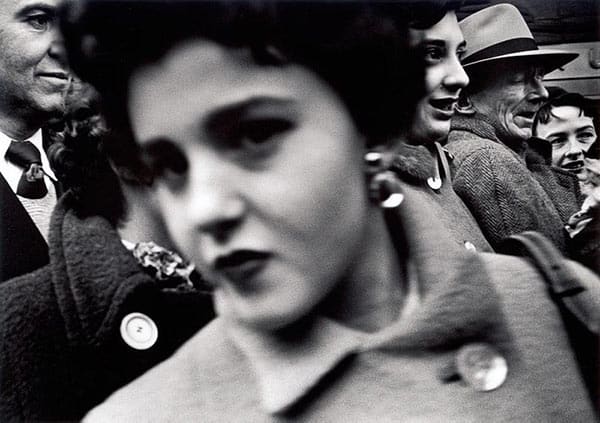
Photographing Cities
The idea of having these cities as the subject of the book was something that came naturally. It became a specialty of mine to do books on cities. So I did about seven cities.
Having lived in France for several years, I thought I had one eye that was European and one that was a street-smart New Yorker.
If I went to Moscow, it’s because I wanted to see how people in a socialist country [were] living, and I hope that the photographs I took would make sense to people… to Russians… to everybody.
I’ve noticed that in general the Paris of photographers… was romantic, foggy and above all, ethnically homogeneous. But for me, Paris was, as much as and perhaps more than New York, a melting pot. A cosmopolitan city, multicultural and totally multiethnic, whatever Le Pen thinks.
In Tokyo [the camera] was more of a mask, a disguise. I had only the vaguest clue to what was going on. I wasn’t there to judge anything. I was an outsider and felt pretty uncomfortable sometimes. Have you ever eaten an official Japanese dinner for four hours on your knees? It was different in New York.
I would say looking back that the book I did [on] New York was my favorite.
William Klein Quotes
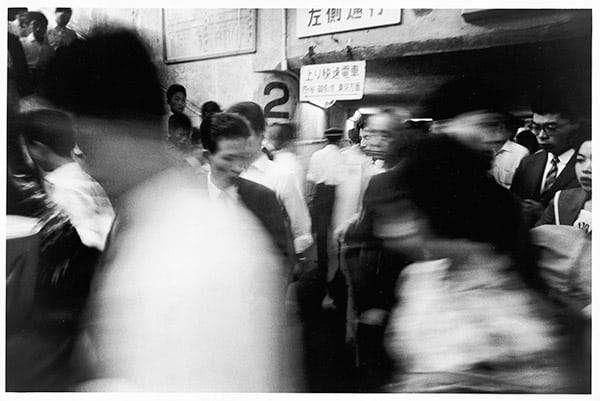
Klein’s New York Book
I thought New York had it coming, that it needed a kick in the balls. When I returned to New York, I wanted to get even. Now I had a weapon, photography.
Before my book on New York, I was a painter. When I came back to the city in 1954, after six years away, I decided to keep a photographic diary of my return. These were practically my first ‘real’ photographs. I had neither training nor complexes. By necessity and by choice, I decided that anything would have to go.
In a way its true I had a lot of old scores to settle. I was involved. According to the Henri Cartier-Bresson scriptures, you’re not to intrude or editorialize, but I don’t see how that’s possible or why it should be. I loved and hated New York. Why shut up about it?
The New York book was a visual diary and it was also kind of personal newspaper. I wanted it to look like the news. I didn’t relate to European photography. It was too poetic and anecdodtal for me… The kinetic quality of New York, the kids, dirt, madness… I tried to find a photographic style that would come close to it. So I would be grainy and contrasted and black. I’d crop, blur, play with the negatives. I didn’t see clean technique being right for New York. I could imagine my pictures lying in the gutter like the New York Daily News.
I saw the book I wanted to do as a tabloid gone berserk, gross, grainy, overinked, with a brutal layout, bull-horn headlines. This is what New York deserved and would get.
In rough neighborhoods in New York [sometimes]… it’s better not to look. So if you point a camera at a stranger, you’re almost breaking a tradition of not getting involved. Yet in a way, the camera erases involvement. Its accepted.
They didn’t know I might be photographing a hundred other things going on behind them – someone lurking in the background, a shadow, a reflection, posters, traffic, junk. [I’d say], ‘Hold it! Don’t move! Hey, look this way!’ People would say, ‘What’s this for?” I’d say, ‘The News.’ ‘The News! Wow! No shit!’ I didn’t much care.
In New York I took responsibility for the people I photographed. I felt I knew them – the people, the way they relate to each other, the streets, the buildings, the city. And I tried to make sense of it all. I just photographed what I saw though its true I used the camera as a weapon in New York.
It was a period of incredible excitement for me – coming to terms with myself, with the city I hated and loved, and with photography. Every day for months I was out gathering evidence. I made up the rules as I went along and they suited me fine.
I was a make believe ethnographer: treating New Yorkers like an explorer would treat Zulus – searching for the rawest snapshot, the zero degree of photography.
William Klein Quotes
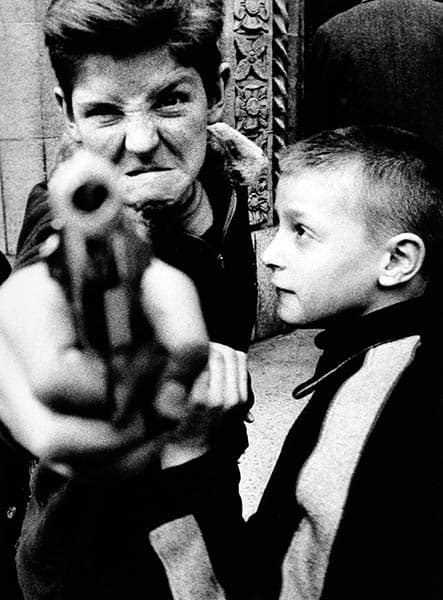
Finding a Publisher for the Book
I spent six months in New York at that time and thought I had a book. So I went to publishers here, in New York, and got nowhere. Most of the people who looked at the photographs looked at the work and said “What kind of book is this? You make New York look like a slum.” I said, “Yeah, New York is a slum.” “What kind of New York are you showing me, everything black and awful?” I said, “No, you live on Fifth Avenue and your office is on Madison. You’ve never been to the Bronx, you’ve never been to Queens or Flatbush. This is the real New York.
In the 1950s I couldn’t find an American publisher for my New York pictures. Everyone I showed them to said, “Ech! This isn’t New York – too ugly , too seedy and too one-sided.” They said, “This isn’t photography, this is shit!”
The layout of my first book was directly inspired by a journal, a tabloid called “New York Daily News” and that was published every day in 3 million copies…That’s how I conceived all my other books, as an extension of a photographic journal across the globe.
The resulting book went against the grain thirty years ago. My approach was not fashionable then nor is it it today.
Photogpedia is an Amazon Associate and earns from qualifying purchases.
Recommended book: William Klein: New York 1954-55
Klein’s New York book is one of the most influential photobooks ever published. His black and white, grainy images perfectly capture the energy of the city and take the viewer on a journey around the neighbourhoods of ’50s New York.
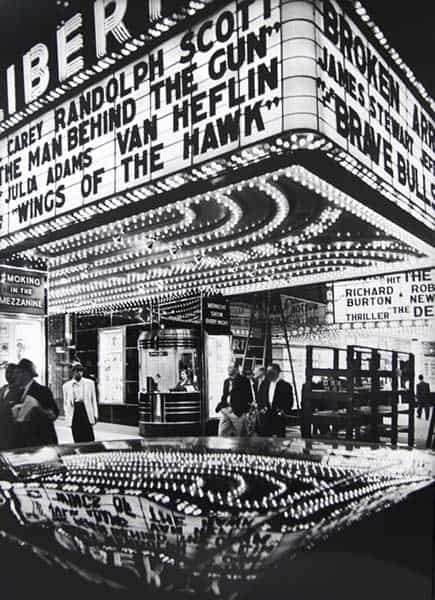
William Klein on Fashion Photography
Fashion came into my life by accident. Liberman had seen an exhibition that I had and he said, “I like what you are doing. Why don’t you come and talk to me at Vogue and we’ll see what we can do together.” I didn’t start making fashion photographs for Vogue. I was financed by Vogue to do this book on New York. As far as fashion was concerned, Liberman said to me at one point, “we are financing these wonderful photos you are taking in the street but we are a fashion magazine. So why don’t you try your hand at fashion?”
I had no idea how to start. I started to look at the fashion magazines, and what was being done. I discovered Penn and Avedon, and for me these were the ideal photographers. For me it was a golden era.
When I started to pose the question of how to take a fashion photograph, I would have to imagine certain things and I had a couple of ideas that I used. And I never used the technique I had of taking street photographs, because I thought that would cheapen the other work, so I tried to invent things which would be specifically fashion photographs, done in a specific way.
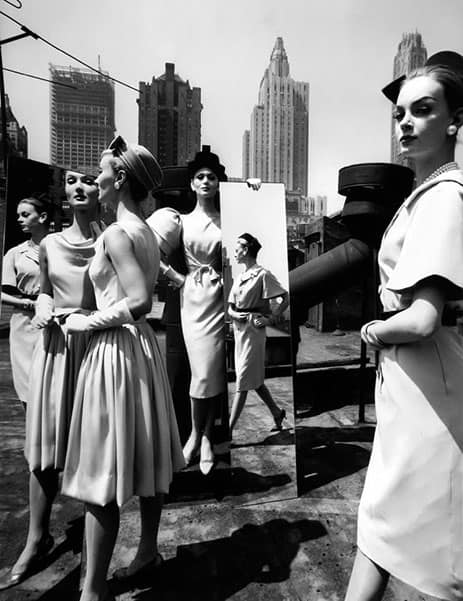
[On Vogue magazine fashion editors] I never went to those meetings – all those women with hats and thick glasses.
Mirrors. I thought that if I have mirrors, then I could shoot the girls on the mirrors. Shoot from the back and I would have a composite photograph.
I discovered working with a telephoto lens was something that I dug. Went out onto the streets with these girls, and told them to cross the street and mix in with traffic and people. And that was the first real, big assignment I gave myself.
I like these situations where things just developed.
[on his most famous fashion photo] I had these girls walking back and forth, doing double-takes because they more or less had the same dress. I was experimenting… with a tele-photo. Nobody could see me. I was half-way up the steps. These men didn’t understand. They thought they were hookers. They walked up and started feeling their ass. The editor from Vogue started panicking and she said, “We’re going to create a scandal.” So we had to stop.
All the photographic stores were besieged by photographers, buying telephoto lenses for their fashion shoots. I think it’s a good idea. I still think it’s a good idea.
[on Who Are You, Polly Maggoo?] The film isn’t about fashion, it’s about media. Fashion is part of media. It is also something which is pretty funny, graphic and inventive. I thought, “lets do a film on fashion.”
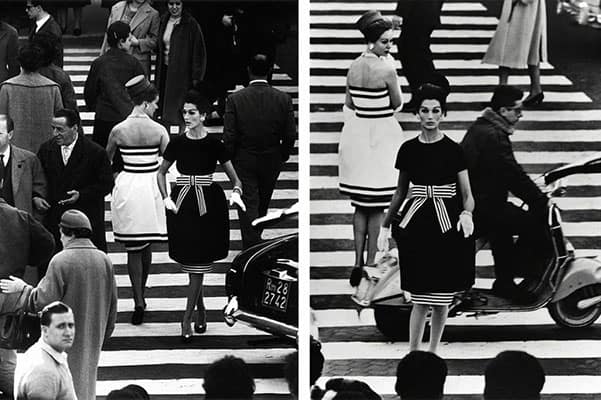
William Klein on Photography Technique
I photographed the panels, and the light wasn’t very good, so the exposure was long, and I had Jan my wife Jan, turn panels while I photographed, and I saw these geometrical forms, which blurred, and I thought, well, maybe this is something new. And I had the idea that if I had a negative, I could do anything with it.
Quite deliberately, I did the opposite to what was usually done. I thought that an absence of framing, chance, use of the accidental and a different relationship with the camera would make it possible to liberate the photographic image. There are some things that only a camera can do. The camera is full of possibilities as yet unexploited. But that is what photography is all about. The camera can surprise us. We must help it do so.
I would look at my contact sheets and my heart would be beating, you know. To see if I’d caught what I wanted. Sometimes, I’d take shots without aiming, just to see what happened. I’d rush into crowds – bang! Bang! I liked the idea of luck and taking a chance, other times I’d frame a composition I saw and plant myself somewhere, longing for some accident to happen.
Choosing location, maybe a symbolic spot, the light and perspective – and suddenly you know the moment is yours. It must be close to what a fighter feels after jabbing and circling and getting hit, when suddenly theres an opening, and bang! Right on the button. It’s a fantastic feeling.
If you look carefully at life, you see blur. Shake your hand blur is a part of life. But why must a photograph be a mirror?
I had neither training nor complexes. By necessity and choice, I decided that anything would have to go. A technique of no taboos: blur, grain, contrast, cock-eyed framing, accidents, whatever happens.
I have always loved the amateur side of photography, automatic photographs, accidental photographs with uncentered compositions, heads cut off, whatever. I incite people to make their self-portraits. I see myself as their walking photo booth.
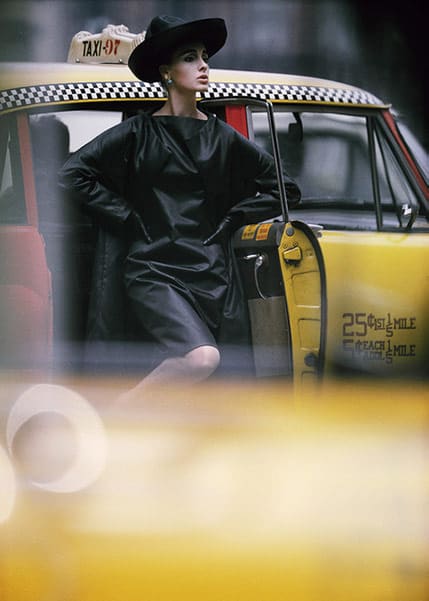
Photography Equipment Quotes
When I started, I only had two lenses: a 50mm and a 135mm. I was very frustrated with the 50 mm and the telephoto lens. I could not put enough things, not enough people in the photo. So I went to a shop and the salesman made me try a 28mm. I immediately went outside and started taking pictures, and I was able to get as close as I wanted to things and people, whilst adding all I wanted in the frame, whilst staying sharp. It was my beginnings with a 28mm, it was a good length. I don’t know if it still exists.
The right filter, the right film, the right exposure – none of that interested me very much. I had only one camera to start with. Secondhand two lenses no filter, none of that. What interested me was getting something on film to put into an enlarger, maybe to get another picture. And I was in a big hurry. Once I got used to everything in New York I knew the trance would wear off. So I took pictures with a vengeance.
I used the wide-angle lens as a normal lens. I had no philosophy about it. When I looked in the viewfinder and realized I could see all the contradictions and confusion that was there with the wide-angle – that was what was great.
I photograph what I see in front of me, I move in close to see better and use a wide-angle lens to get as much as possible in the frame.
I’m not deliberately distorting. I need the wide-angle to get a lot of things into the frame. Take the picture of may day in Moscow. With a 50mm jammed between the parade and the side-walk, I would have been able to frame only the old lady in the middle. But what I wanted was the whole group – the tartars, the Armenians, Ukranians, Russians, an image of empire surrounding one old lady on a sidewalk as a parade goes by.
Most things I did with photography are considered acceptable today – except maybe this use of a wide-angle. It seemed more normal to me than the 50mm lens. You could even say the 50mm is an imposition of a limited point of view. But neither lens is really normal or correct. Because in life we see out of two eyes, whereas the camera has only one. So whatever lens is used, all photographs are deformations of what you actually see with your eyes.
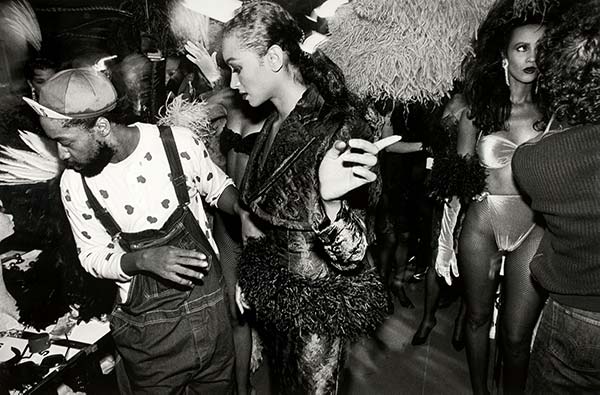
The Anti-Photograph
In photography, I was interested in letting the machine loose, in taking risks, exploring the possibilities of film, paper, printing in different ways, playing with exposures, with composition and accidents. Its all part of what an image can be, which is anything. Good pictures, bad pictures – why not?
I came from the outside, the rules of photography didn’t interest me… there were things you could do with a camera that you couldn’t do with any other medium… grain, contrast, blur, cock-eyed framing, eliminating or exaggerating grey tones and so on. I thought it would be good to show what’s possible, to say that this is as valid of a way of using the camera as conventional approaches.
So who can pin down photography? We’re drunk with images. [Sontag’s] sick of it. I’m sick of it. But we’re moved by old amateur photographs because they aren’t concerned about theories of photography or what a picture must be. They’re just photographs without rules or dogma.
I have always done the opposite of what I was trained to do… Having little technical background, I became a photographer. Adopting a machine, I do my utmost to make it malfunction. For me, to make a photograph is to make an anti-photograph.
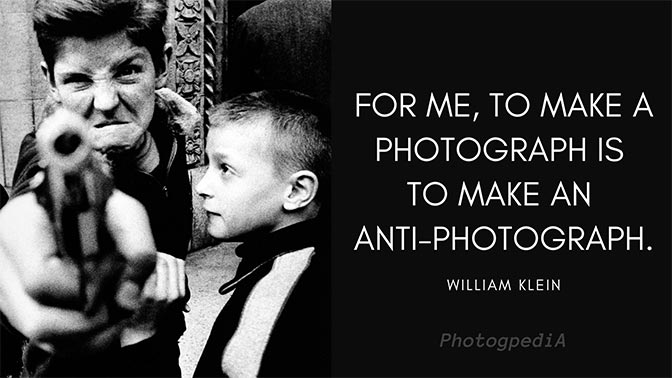
What’s your Favorite William Klein Quote?
Have a favorite William Klein quote from the list? Let us know in the comment section below.
Don’t forget to bookmark this page, or print it out, and refer to it next time you need some inspiration. If you’ve enjoyed the article, we would be grateful if you could share it with other photographers.
To see more of Klein’s remarkable street and fashion photography, check his artist profile at ArtNet.
Looking for more words of wisdom from master photographers? Visit the quotes section of Photogpedia for more great photography quotes.
Related Quote Articles:

